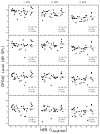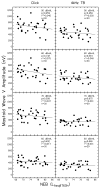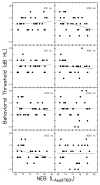Auditory function in normal-hearing, noise-exposed human ears
- PMID: 25350405
- PMCID: PMC4374361
- DOI: 10.1097/AUD.0000000000000107
Auditory function in normal-hearing, noise-exposed human ears
Abstract
Objectives: To determine whether suprathreshold measures of auditory function, such as distortion-product otoacoustic emissions (DPOAEs) and auditory brainstem responses (ABRs), are correlated with noise exposure history in normal-hearing human ears. Recent data from animal studies have revealed significant deafferentation of auditory nerve fibers after full recovery from temporary noise-induced hearing loss. Furthermore, these data report smaller ABR wave I amplitudes in noise-exposed animal ears when compared with non-noise-exposed control animals or prenoise exposure amplitudes in the same animal. It is unknown whether a similar phenomenon exists in the normal-hearing, noise-exposed human ear.
Design: Thirty normal-hearing human subjects with a range of noise exposure backgrounds (NEBs) participated in this study. NEB was quantified by the use of a noise exposure questionnaire that extensively queried loud sound exposure during the previous 12 months. DPOAEs were collected at three f2s (1, 2, and 4 kHz) over a range of L2s. DPOAE stimulus level began at 80 dB forward-pressure level and decreased in 10 dB steps. Two-channel ABRs were collected in response to click stimuli and 4 kHz tone bursts; one channel used an ipsilateral mastoid electrode and the other an ipsilateral tympanic membrane electrode. ABR stimulus level began at 90 dB nHL and was decreased in 10 dB steps. Amplitudes of waves I and V of the ABR were analyzed.
Results: A statistically significant relationship between ABR wave I amplitude and NEB was found for clicked-evoked ABRs recorded at a stimulus level of 90 dB nHL using a mastoid recording electrode. For this condition, ABR wave I amplitudes decreased as a function of NEB. Similar systematic trends were present for ABRs collected in response to clicks and 4 kHz tone bursts at additional suprathreshold stimulation levels (≥70 dB nHL). The relationship weakened and disappeared with decreases in stimulation level (≤60 dB nHL). Similar patterns were present for ABRs collected using a tympanic membrane electrode. However, these relationships were not statistically significant and were weaker and more variable than those collected using a mastoid electrode. In contrast to the findings for ABR wave I, wave V amplitude was not significantly related to NEB. Furthermore, there was no evidence of a systematic relationship between suprathreshold DPOAEs and NEB.
Conclusions: A systematic trend of smaller ABR wave I amplitudes was found in normal-hearing human ears with greater amounts of voluntary NEB in response to suprathreshold clicks and 4 kHz tone bursts. These findings are consistent with the data from previous work completed in animals, where the reduction in suprathreshold responses was a result of deafferentation of high-threshold/low-spontaneous rate auditory nerve fibers. These data suggest that a similar mechanism might be operating in human ears after exposure to high sound levels. However, evidence of this damage is only apparent when examining suprathreshold wave I amplitude of the ABR. In contrast, suprathreshold DPOAE level was not significantly related to NEB. This was expected, given noise-induced auditory damage findings in animal ears did not extend to the outer hair cells, the generator for the DPOAE response.
Figures







Comment in
-
Letter to the Editor: Examination of Potential Sex Influences in . Auditory Function in Normal-Hearing, Noise-Exposed Human Ears, Ear Hear, 36, 172-184.Ear Hear. 2015 Nov-Dec;36(6):738-40. doi: 10.1097/AUD.0000000000000228. Ear Hear. 2015. PMID: 26441036 Free PMC article. No abstract available.
References
-
- ANSI. ANSI Report No. S3.6-2004. New York: American National Standards Institute; 2004. Specifications for Audiometers.
-
- Attias J, Horovitz G, El-Hatib N, et al. Detection and Clinical Diagnosis of Noise-Induced Hearing Loss by Otoacoustic Emissions. Noise Health. 2001;3:19–31. - PubMed
-
- Bohne BA, Harding GW. Degeneration in the cochlea after noise damage: primary versus secondary events. Am J Otol. 2000;21:505–509. - PubMed
-
- Chasin M. Clinical assessment of musicians – audiologist as a detective. In: Chasin M, editor. Musicians and the Prevention of Hearing Loss. San Diego: Singular Publishing Group, Inc; 1996. pp. 103–119.
-
- Cohen J. A power primer. Psychol Bull. 1992;112:155–159. - PubMed
Publication types
MeSH terms
Grants and funding
LinkOut - more resources
Full Text Sources
Medical
Miscellaneous

